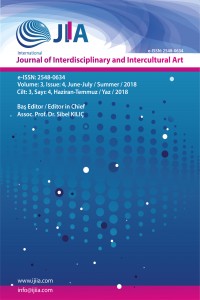Makroskopik görünüşleri ve mikroskopik yapılarına göre doğal fosilleşmiş ağaçların (SiO2) sınıflandırılması; Güdül-Ankara bölgesi fosil ağaç ormanı örneği
Öz
Organik kökenli silisleşmiş ağaçlar, ebatlı kesildikten ve cilalandıktan sonra, binalarda dekoratif iç yüzey kaplama taşları ve/veya dekoratif süstaşı objeleri olarak tüm dünyada yaygınca kullanılmaktadırlar. Türkiye’de yaklaşık 20-12 Milyon yıl önceki dönemlerde silisleşerek taşlaşmış büyük bir fosil ağaç ormanı, Ankara ilinin Çamlıdere ve Güdül ilçeleri arasında Çeltikçi beldesi yakınlarında yer almaktadır. Oldukça büyük bir fosilleşmiş ağaç rezervine sahip bu alandan elde edilen malzemelerin sağlamlık, duraylılık ve ağırlıkça heterojen bir yapıya sahip olması, bu tür malzemelerin standartlaştırılmasında önemli bir problem olarak ortaya çıkmaktadır. Ham malzemenin kesilip cilalanmadan evvel standartlaştırılması için, kendi içerisinde belirgin özelliklerine göre gruplandırılması (bir örnek yapılması) da gerekmektedir. Bu bağlamda sadece gövde rengine ve dış görünüşüne göre fosilleşmiş ağaçları sınıflandırmak yetersiz olup, bunlara ilaveten bölgedeki fosilleşmiş ağaçların gruplandırılmasında, malzemenin silisleşmesi sürecinde oluşan en önemli parametreler olan kristalin derecesi ve buna bağlı silis tanecik boyutlarının da dikkate alınması gerekmektedir. Türkiye’deki fosilleşmiş ağaçlar üzerinde ilk kez yapılan bu çalışmada, Güdül-Ankara (Çeltikçi civarı) bölgesinden toplanan örnekler; Birinci olarak renklenme ve özgül ağırlık değerlerine göre beş farklı gruba ayrılmışlardır. İkinci olarak da, kristalin derecesi ve buna bağlı silis parçacık boyutuna ve de kalsedonik ve opalin kuvars mineral türlerine göre fosilleşmiş ağaçlar üç alt grupta toplanmışlardır. Böylece, ağırlık, sağlamlık ve duraylılık derecelendirmesinde, fosilleşmiş ağaçlardan birinci alt gruptakiler ağır, sağlam ve dayanıklı, ikinci alt gruptakiler orta ağır, yarı sağlam ve orta dayanıklı ve son olarak üçüncü alt gruptakiler de hafif, kırılgan ve düşük dayanımlı malzemeler olarak derecelendirilmişlerdir.
Anahtar Kelimeler
Fosilleşmiş ağaçlar malzeme derecelendirmesi homojenizasyon Güdül-Ankara bölgesi
Kaynakça
- Akahane H, Furuno T, Miyajima H, Yoshikawa T ve Yamamoto, S, “Rapid wood silicification in hot spring water: an explanation of silicification of wood during the Earth’s history” Sediment. Geol. Vol. 169, 219–228 (2004). [2] Krauskopf, K. B., “Introduction to Geochemistry”, 2nd Ed., McGraw-Hill Book Co., Sydney (1982). [3] Scurfield G ve Segnit E R, “Petrification of wood by silica minerals” Sediment. Geol. Vol. 39, 149–167 (1984). [4] Tankut A, Wilson M ve Yihunie T, “Geochemistry and tectonic setting of Tertiary volcanism in the Güvem area, Anatolia, Turkey” J. Volcanol. Geotherm. Res. Vol. 85, 285-301 (1998). [5] Hatipoglu M ve Türk N, “A combined polarizing microscope, XRD, SEM, and specific gravity study of the petrified woods of volcanic origin from the Çamlıdere-Çeltikçi-Güdül fossil forest, in Ankara, Turkey” J. Afr. Earth Sci. doi:10.1016/j.jafrearsci.2009.01.001 (2009). [6] Wilson M, Tankut A ve Güleç N, “Tertiary volcanism of the Galatia province, north-west Central Anatolia, Turkey” Lithos, Vol. 42, 105-121 (1997). [7] Paicheler J C, “Beşkonak (Kuzey Anadolu-Turkiye) Tersiyer Gölünde volkanik paleoortam ve tortul katkı örnekleri” TJK Bülteni, Cilt 21, 11-26 (1978). [8] Yavuz-Işık N. “Güvem Havzası (Orta Anadolu) Alt Miosen Gölsel Sedimanlarının Palinolojisi”, 61. Türkiye Jeoloji Kurultayı, Ankara, 337 (2008). [9] Akkemik, Ü., Acarca, N. N., Hatipoğlu, M., The first Glyptostroboxylon from the Miocene of Turkey. IAWA Journal, 38(4), 561-570. (2017). DOI: 10.1163/22941932-20170181 [10] Frondel C, “Systematic compositional zoning in the quartz fibres of agates” Am. Mineral. Vol. 70, 975–979 (1985). [11] Heaney P J, “A proposed mechanism for the growth of chalcedony” Contrib. Mineral. Petrol. Vol. 115, 66-74 (1993). [12] Jones J B and Segnit E R, “The nature of opal I. Nomenclature and constituent phases” Aust. J. Earth Sci. Vol. 18, 57-68 (1971). [13] Lynne B Y ve Campbell K A, “Diagenetic transformation (opal-A to quartz) of low- and midtemperature microbial textures in siliceous hot-spring deposits, Taupo Volcanic Zone, New Zealand” Can. J. Earth Sci. Vol. 40, 1679-1696 (2003). [14] Miehe G, Graetsch H ve Flörke O W, “Crystal structure and growth fabric of length-fast chalcedony” Phys. Chem. Miner. Vol. 10, 197-199 (1984). [15] Murashov V V, ve Svishchev I M, “Quartz family of silica polymorphs: Comparative simulation study of quartz, moganite, and orthorhombic silica, and their phase transformations” Phys. Rev. B: Condens. Matter. Vol. 57, 5639-5646 (1998). [16] Smith D K, “Opal, cristobalite, and tridymite; noncrystallinity versus crystallinity nomenclature of the silica minerals and bibliography” Powder Diffr. Vol. 13, 2-19 (1998). [17] Fritsch E, Gaillou E, Rondeau R, Barreau A, Albertini D ve Ostrooumov M, 2006. “The Nanostructure of fire opal” J. Non-Cryst. Solids, Vol. 352, 3957-3960 (2006). [18] Back, M., Mandarino, J., “Fleischer’s Glossary of Mineral Species”, 10th Ed., The Mineralogical Record, Inc., Tucson (2008). [19] Pretola J P, “A feasibility study using silica polymorph ratios for sourcing chert and chalcedony lithic materials” J. Archaeol. Sci. Vol. 28, 721-739 (2001).
Ayrıntılar
| Birincil Dil | Türkçe |
|---|---|
| Bölüm | Araştırma Makalesi |
| Yazarlar | |
| Yayımlanma Tarihi | 31 Temmuz 2018 |
| Yayımlandığı Sayı | Yıl 2018 Cilt: 3 Sayı: 4 |


